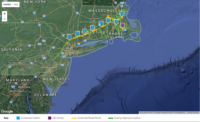Construction of a proposed multibillion-dollar Durban Dug-Out Port in South Africa has been postponed once again, after the country’s biggest state-run rail, port and pipeline company, Transnet SOC Ltd., said a sluggish economy and declining global commodity prices have sapped the performance of its subsidiary, the Transnet National Ports Authority (TNPA), which is promoting the project.
Transnet CEO Siyabonga Gama on June 27 announced that the company will suspend some of its major capital projects across its port, pipeline and railway operations. Those projects had been scheduled as part of a 10-year, $20-billion rolling-market demand-strategy investment plan unveiled in 2012.
“We have had to defer some of the capital investment projects because our customers are also scaling down on their investment expenditure, largely due to the subdued global commodity markets and a GDP that is below expectations,” said Gama.
“We now do not want to create too much capacity ahead of demand. What we are doing is to time our investments in such a manner that [they are] based on validated demand,” said Gama. “We want to enter into discussions with our customers for take-or-pay programs [in which] they can guarantee our port volumes and that the investments we make will actually pay back,” he said.
Phase-one construction of the “dug-out” port, whose cost has been estimated at between $5.2 billion and $6.8 billion, was set to begin this year, but the final designs, earlier slated for completion in 2014, are still pending. No new target start date has been announced. Transnet did not respond to ENR’s emailed requests for additional information.
The project is to be located at the old Durban International Airport site, which sits 11 kilometers from the existing Port of Durban. Completion of the first phase had been set for 2020, to coincide with an anticipated 76% increase in container volumes to 7.6-million twenty-foot equivalent units (TEU) from 4.3-million TEU, between 2012 and 2019, according to Transnet’s 2012 container-volume growth projections.
The proposed port is expected to have a capacity of 9.5-million TEU per year—nearly three times the 3.4-million TEU of the existing one, which handles 65% of all South Africa container traffic and 4,700 commercial vessels annually.
Some features of the proposed port include an 18.5-meter-deep, 360-m-wide approach tunnel, a 16-berth container terminal, a three-berth vehicle terminal and a 300-m-long, 4-berth liquid terminal. Other features include cargo infrastructure and services to facilitate port functions. Transnet says the port will take 20 to 40 years to construct.
TNPA originally set 2016 as the deadline for award of concessions and construction tenders for the first four berths, breakwaters and channel dredging. The projects were planned for completion in the first quarter of 2020.
The project is opposed by ecological and residential groups in South Africa. The South Durban Community Environmental Alliance, a Durban-based environmental justice organization, says the project “will not only have negative social and economic impacts but will detrimentally affect the environment around the mouth of the Isipingo River [and] contribute to further climate change, loss of natural resources and the extinction of species.” The site is thought to have one of the highest mother populations of black-headed dwarf chameleons, according to the alliance.
Other TNPA projects still are on track. At an estimated cost of $829 million, the existing Durban Container Terminal will expand the capacity at Pier 1 and Pier 2, enabling them to handle a combined 5.3-million TEU annually.
Preparations are to begin next year, according to Selvan Pillay, senior manager for planning and development. The second phase of Pier 1 expansion involves the integration of the nearby Salisbury Island naval base and the container terminal, he said on June 27.
“We are working at getting a lease agreement for the Salisbury land. … Also, we have to do an environmental process to enable us to get the project approved,” Pillay said. Pier 1 construction is expected to commence in 2018 and be completed in 2023. Costing an estimated $439 million, the project will increase the container terminal’s capacity to 2.4-million TEU from 700,000 TEU per year.
At Pier 2, Nos. 203, 204 and 205 berths will be deepened to 16.5 m from the current 12.8 m. Further, they will be extended to 1,210 m from the current 914 m, allowing each of the berths to accommodate simultaneously three vessels of 350-m lengths.
This expansion will increase the capacity of Pier 2 to 2.9-million TEU per year from the current 2.4-million TEU. The project, including additional lift cranes, is expected to cost $390 million. Work on Pier 2 is expected to commence in 2017 and run until 2022.
In one of its project briefs, TNPA says two Durban Container Terminal projects will require "sand winning" of approximately 4.5 million cu m of offshore material. Two borrow sites, measuring 110 hectares and 250 ha, respectively, have been identified 1.2 kilometers east of the Port of Durban harbor's mouth.
Either a trailing suction dredger or a trailing suction hopper dredger will mine the material, according to TNPA. “Both of [the dredgers] are self-propelled ships equipped with articulated dredging pipes that extend to the sea bottom,” according to the firm.
TNPA will review a number marine, environmental and archaeological studies after August 15, when the interested parties conclude registration.





Post a comment to this article
Report Abusive Comment